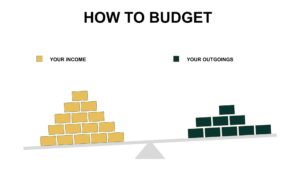A simple but effective system for budgeting your money. The following is a system that will enable you to budget your money effectively. The goal is to balance your personal income so you can build your retirement plan from a solid foundation.

The most important part of money management is to separate your finances into different type of expense accounts. The easiest way to achieve this, is to create separate bank accounts for each requirement.
| Account Type | Example Account Name |
| Taxes | Your Name, TAXES |
| Financial Freedom | Your Name, FREE |
| Bills and Necessities | Your Name, BILLS |
| Cash Flow | Your Name, CASH |
| Fun and Play | Your Name, PLAY |
| Long-Term Savings | Your Name, SAVE |
Taxes (Your Name, TAXES): Pay your tax money into this account as soon as you receive your income. However, this account is not needed if you are taxed at source, that is pay as you earn (PAYE), and you do not pay your taxes separately.
Financial Freedom (Your Name, FREE): Use this account to save for a passive residual income to gain financial independence. This account will most likely include other accounts as well such as stocks and shares, ISAs, ETFs, REITs, SIPPs, pensions and mutual funds. This account will eventually cover all your living expenses and provide you with abundance.
Money attracts money – this is your money growth account.
Every day add money to your financial freedom account, even if it is only a pound. It is not the amount that is important, as much as developing the habit.
Invest this money and eventually you will earn interest that you can then spend, but never spend the principal! The purpose is to create a golden goose that will keep on laying golden eggs. Eventually you will be able to spend the golden eggs but NEVER, NEVER spend the golden goose itself. Long live the goose!!!
Put a minimum of 10% of your income into this account.
Bills and Necessities (Your Name, BILLS): This account covers regular expenses such as mortgage payments, rent, water, gas, electricity, insurances, car payments, etc. It is from this account that you pay your immediate bills. You can set up regular payments such as direct debits and standing orders.
This is the account that your salary is paid into. From here you immediately distribute your funds into your other accounts.
Once your car, a credit card or a loan is paid off, a typical reaction is to then spend this money on other expenses. Deeply consider making these payments into your own long-term savings account or even better, your financial freedom account.
An ideal situation would be 50% of your income covers your bills and necessities and the other 50% can be distributed into your other accounts. If you cannot pay all your bills with the 50% remainder, try simplifying your life or developing new skills to generate extra cash flow.
Cash Flow (Your Name, CASH): This account contains your cash flow. This is where you spend your daily and weekly needs such as food, fuel, travel, coffees, etc. Typically, this will be the bank account for which you will use debit card. Pay enough money into this account to fund your daily, weekly or monthly living expenses.
Fun and Play (Your Name, PLAY): You must have fun. This is your entertainment account, so enjoy it. Use the money from this account and treat yourself. If you do save this money from one month to the next, treat yourself to whatever has accumulated. This is very important, as it helps keep you motivated and focused.
Place 10% of your income into this account.
Long-Term Savings (Your Name, SAVE): This account is used to save up for one-off payments such as holidays, larger items such as cars, boats or campervans, repairing and replacing items that break or wear out, and unforeseen circumstances.
Put 10% of your income into this account.
This account is also your contingency fund for unexpected expenses. Do not call it your ‘emergency fund’ or ‘rainy day account’, because what you focus on expands.
If you have debts, split this account into two accounts. The first account serves the above purpose. The second SAVE account is used to pay down the principal of your existing debts such as a mortgage.
Instead of putting 10% of your income into your one SAVE account, put 5% into each of these two SAVE accounts.
In addition to the above accounts, once your finances are in good shape and you are saving a substantial amount of your income, you may also consider adding to the above accounts: Training and Gifting.
- Education and Training: (Your Name, LEARN): To invest in your future, you need to invest in yourself: if you are not growing you are dying. This money is used for training, buying books etc.Put 5% of your income into this account.
- Gifting: (Your Name, GIFT): To be balanced in your money management, as well as saving, you also need to give a little away. This account is used to give to good causes such as charities and gifts, without expecting anything back in return.Put 5% of your income into this account.Some people pay more into this account such as 10%.
If you have a family or a partner, it is advantageous to pool resources, or your spouse / partner may also want their own personalised money management system. You may choose to share just the Bills (BILLS) and Long-Term Savings (SAVE) accounts as a minimum.
If you have children, try to get them into the habit of managing their money at an early age. Children learn best by imitation. If they are too young to own a bank account, provide them with money jars, clearly labelled, to accommodate their savings.
Split their allowances into the Financial Freedom (FREE), Cash Flow (CASH), Fun and Play (PLAY), and Long-Term Savings (SAVE) accounts.
When they are teenagers, they will also need to be given the Bills and Necessities (BILLS) account.
Once you have achieved balance with your income you are one step closer to achieving retirement prosperity and financial self-sufficiency.
